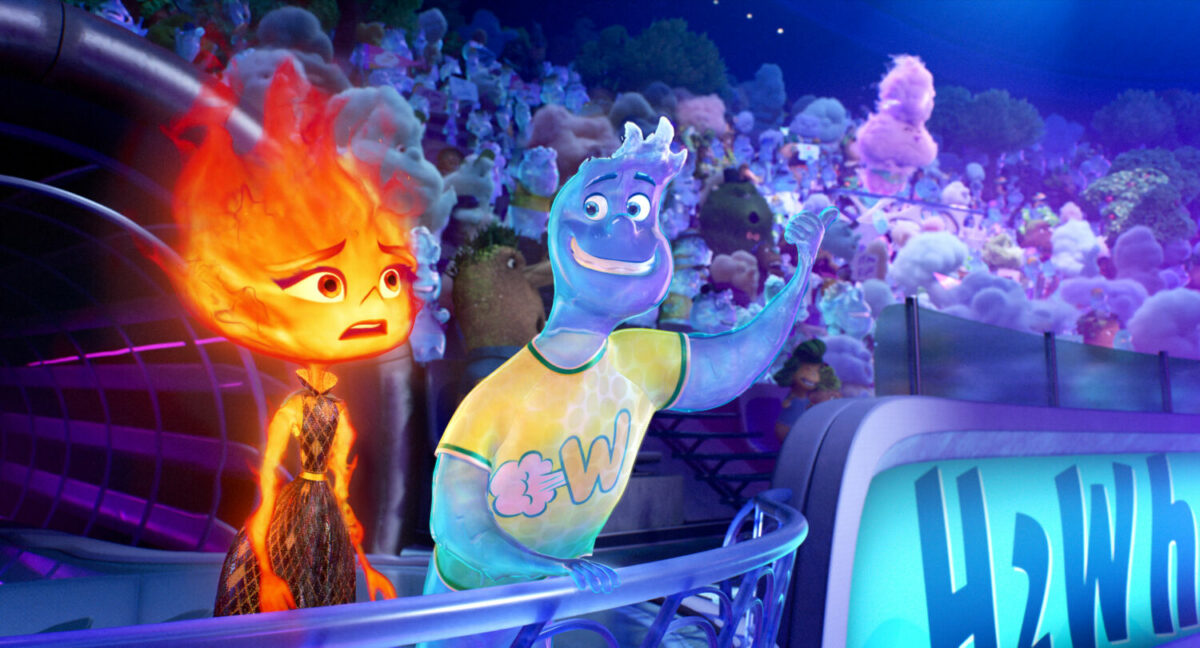One year after releasing Lightyear, Pixar is back with an original movie called Elemental. This time, there’s no infinity and beyond to explore; instead, it touches on the classic elemental bond – quite literally. Directed by Peter Sohn (aka the voice of Buzz Lightyear’s feline friend Sox), the movie takes viewers into Element City, a fictional city where all four elements – water, air, earth and fire – live together.
The story follows a character named Ember (Leah Lewis) who works at a store built by her immigrant parents Bernie (Ronnie del Carmen) and Cinder (Sheila Vosough) who left their homeland, Fireland, in search of a newer, better life for themselves.
Ember and her family are made out of fire, and as established by the first 15 minutes of the film, Fire folks aren’t exactly welcomed in Element City, which has been architecturally designed to suit the needs of Water residents. Water, Earth and Air residents have jobs, live, and play in the heart of Element City whereas Fire folks are only found in a small, peculiar neighbourhood that is a bridge and a train ride away from the city centre.

In some ways, the world of Elemental mirrors Sohn’s own life who comes from a Korean immigrant family that moved to the big apple, New York City. Even if you’re not familiar with Sohn’s background, it is quite evident that Fire residents aim to mimic minority Asian immigrants, especially since they are the only elements that uphold distinct Asian family values like filial piety, respect for elders, and displaying service not just to one’s family, but to the wider community as well.
The other elements, in contrast, are a complete juxtaposition of Fire residents and their way of life, likely to represent Western ideals. This is further perpetuated via the Water character Wade (Mamoudou Athie) who is the opposite of Ember. Ember has a temper, whereas Wade is calm. Ember keeps her emotions and thoughts in a lock and Wade is as emotionally open as it gets. The differences don’t stop there – the Water citizen comes from a privileged family, while Ember’s family had to build their life from scratch. And unlike Ember’s obligation to inherit her father’s store someday, Wade is free to pursue his multiple endeavours with support from his mother, who is accepting of anyone’s individuality, be it pursuing a career in painting or being queer.

As expected, Ember and Wade start falling in love with each other despite being different elements. Their relationship goes back and forth with the two falling deeper, only to be pulled apart by Ember’s hesitance and fear of disappointing her parents by dating a Water resident.
It’s classic Romeo and Juliet forbidden love with the added complexities of interracial – or in this case, interelement – relationships.
In addition to the love story, Ember is also determined to save her father’s store from being shut down due to a water leak problem in the city, but realises halfway that she doesn’t actually want to inherit the family business. Wade encourages her to chase her dreams and simply tell her father what she’s thinking, which seems logical and easy enough – until you realise the implications of being brought up in a traditional, Asian household: oppose your parents, and you’re as good as dead (metaphorically). This plotline is reminiscent of Mulan where she sacrifices her own desires in order to protect her elderly father and of Turning Red, where parent-child relationships aren’t as straightforward as it seems.
Interracial relationships, father-daughter relationships and the immigrant experience are the major themes explored in Elemental and seeing how these characters are not racialised, viewers are likely able to relate and resonate with some, if not all, of the themes present depending on their own personal background and experiences. Elemental has no issues connecting with any viewer and in classic Pixar fashion, there’s a high chance one of these varying topics will tug on your heartstrings or even cause you to shed a tear or two.

Despite the social commentary, Elemental doesn’t offer anything new or refreshing in terms of story. As mentioned, the well-worn narrative has seen many iterations over the years, from
Romeo and Juliet and Mulan to Turning Red. Don’t be mistaken – Elemental is still a beautiful story, but the combination of three all-too-familiar major themes into one movie does feel a little overdone, resulting in surface-level emotional payoff.
What is unique about Elemental though, is its animation style. Unlike other Pixar movies like Up and Soul, it focuses less on the physical human-ness of the characters, and instead adds an element of realism to the mix. For instance, Ember turns purple when she’s angry, and has her flame doused when she’s upset. Likewise, Wade is never in a solid form, with his body flowing seamlessly and changing shapes constantly. There’s plenty of attention to detail here, and it’s evident that a big amount of heart has been put into making these characters a personification of these elements.
A love story at heart, Elemental tells a beautiful tale of boy-meets-girl and how their varying complexities come into play in their relationship. It bears some thematic influences of familial relationships and putting oneself first that will likely touch viewers who are in their 20s or are in similar stages of their lives. For the general audience, the vivid colours and unique animation style make for a pleasant, delightful watch.
GEEK REVIEW SCORE
Summary
Forbidden love, filial piety and choosing your own path – Elemental takes familiar storytelling elements and tropes, and puts a spin on them.
Overall
6.9/10-
Story - 6.5/10
6.5/10
-
Direction - 7/10
7/10
-
Characterisation - 7/10
7/10
-
Geek Satisfaction - 7/10
7/10













